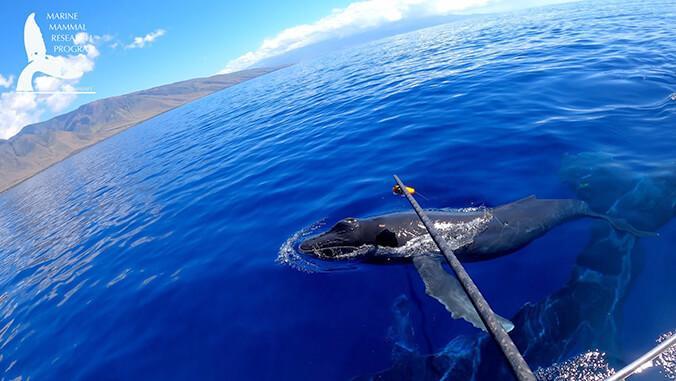Video news release

Credit: UH Mānoa Marine Mammal Research Program
WHAT: An exciting new project that aims to quantify the nursing behavior of humpback whale calves in the Maui breeding grounds.
The project is a collaboration between the University of Hawaiʻi at Mānoa Marine Mammal Research Program, the Goldbogen Lab at Stanford University’s Hopkins Marine Station and the Friedlander Lab at University of California, Santa Cruz.
WHO: UH Mānoa Marine Mammal Research Program Director Lars Bejder, PhD candidates Martin van Aswegen and Will Gough.
HOW: Researchers deployed non-invasive suction-cup tags with cameras, acoustic recorders, depth sensors and accelerometers onto seven humpback whale calves. The camera recordings are providing researchers with seldom seen nursing behavior (including nursing bout frequency and durations) and social interactions between individuals. The accelerometer data allows them to quantify the fine-scale behavior, movement and breathing patterns of tagged whales. The fieldwork also consisted of flying drones over the tagged whales, allowing researchers to calculate their overall length, body condition and health.
WHEN: The project took place over 10 days in February 2020.
WHY: The data collected will provide important insights into the needs of humpback mothers and calves in the Maui breeding grounds.
OTHER FACTS:
- Every winter, about 10,000 humpback whales migrate to Hawaiʻi, with the main purpose of breeding. The time period during which adult females and their newborn calves spend on the Hawaiian breeding grounds (typically January – March) represents a critical time.
- No feeding occurs during the breeding season, so the whales are reliant on energy stored from the earlier feeding season in Alaska.
- The tag deployments were made possible with the generous support of Marc Lammers from the Hawaiian Islands Humpback Whale Sanctuary, Stephanie Stack and Jens Currie from the Pacific Whale Foundation and the Oceanwide Science Institute.
- Molokai Ocean Tours, PacWhale Eco-Adventures and Rachel and John Sprague were all instrumental in helping to retrieve the tags once they were off of the whales.
- Keep up to date through the MMRP website and social media platforms (Twitter and Instagram: @MMRP_UH, Facebook: MMRPUH, Youtube: MMRP UH) to build awareness. To help achieve its mission, the program is also accepting donations to fund research initiatives and student scholarships. All donations are tax-exempt.
- All research activities were conducted in accordance with NOAA permit #21476 and institutional animal care and use committee approval. All drone activities were conducted in accordance with FAA Part 107 regulations.
###
VIDEO: TRT 2:12
(NOTE: “Permit Number: NOAA #21476” MUST be on screen at least :05 seconds during use of any whale video below AND must be included in any photo captions)
SOUND:
Lars Bejder, Director, UH Mānoa Marine Mammal Research Program (:15)
“So we can actually see what these animals are seeing and encountering and experiencing themselves. And it’s quite unique and rare footage that we’re obtaining, which is allowing us to quantify these nursing and suckling bouts that’s so important.”
Bejder (:12)
“What we are trying to understand with these new technologies is how much time the calves need to nurse from their moms to be able to get strong and big enough to make their journey back up north.”
BROLL: (NOTE: “Permit Number: NOAA #21476” MUST be on screen at least :05 seconds during use of any whale video below AND must be included in any photo captions)
1 shot from boat on the water
1 shot of humpback whale and calf spouting near surface
1 shot of tagging calf from boat
2 shots mother and tagged calf swimming
1 underwater shot from camera on tagged calf
1 shot tagging calf from boat
1 split screen showing underwater and overhead drone shots of whale and calf
1 overhead shot of calf swimming above mother
1 underwater shot of calf nursing
1 underwater shot swimming past another whale
1 shot Lars Bejder on land holding up device to track tags
Photos:
1. UH researchers tag a humpback whale calf off of Maui (NOAA permit #21476)
2. A humpback whale nurses her calf. (NOAA permit #21476)
3. A humpback whale and calf with suction cup tag (NOAA permit #21476)
Link to video and sound (details below): https:/
(NOTE: “Permit Number: NOAA #21476” MUST be on screen at least :05 seconds during use of any whale video below AND must be included in any photo captions)
Media Contact
Kelli Abe Trifonovitch
[email protected]





